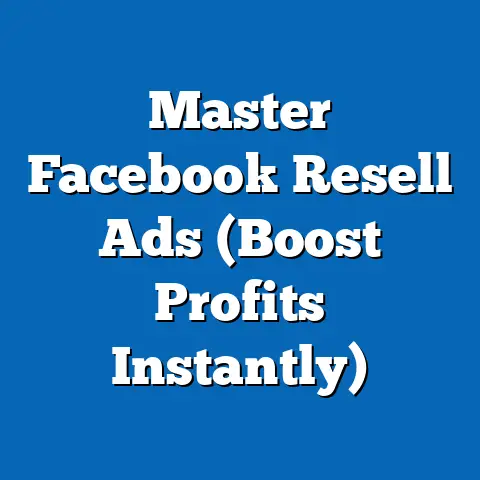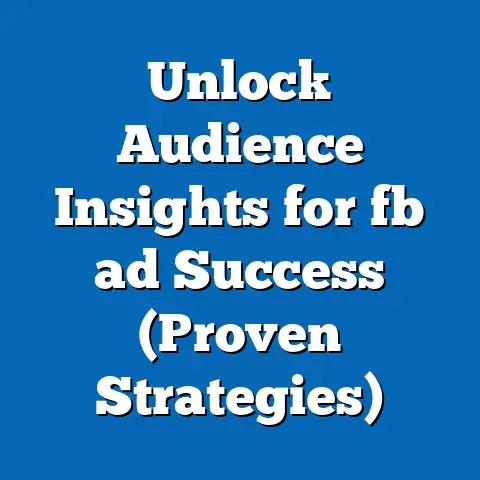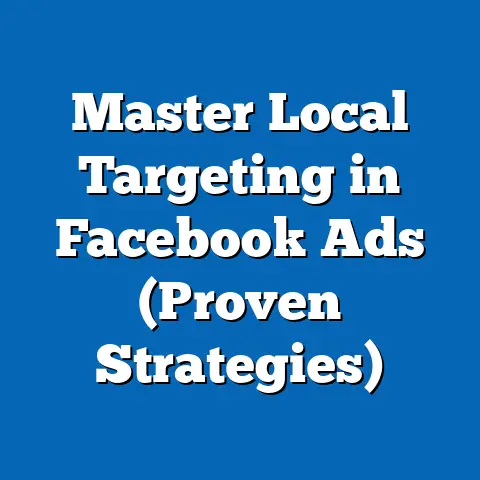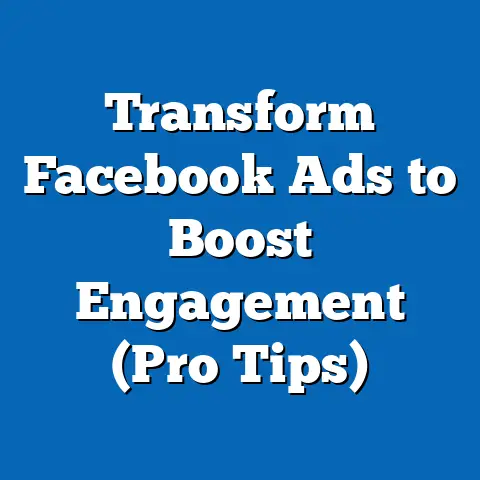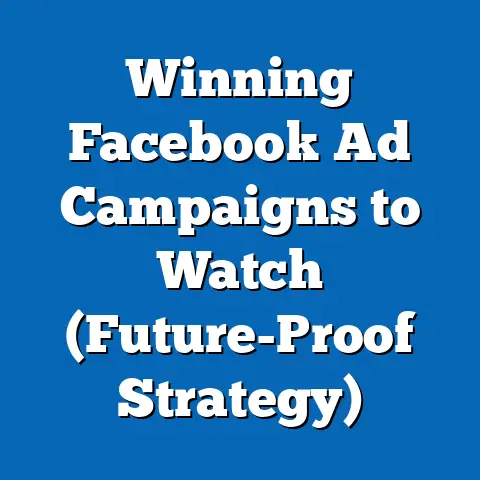Crafting Irresistible Facebook Image Ads (Expert Strategies)
What makes a dish irresistible to your taste buds? Is it the vibrant colors, the tantalizing aroma, or the perfect blend of flavors? Just as a chef carefully crafts a culinary masterpiece, crafting a compelling Facebook image ad requires a similar level of artistry and attention to detail. In the crowded digital landscape, first impressions are everything. A captivating image ad can evoke emotions, spark curiosity, and ultimately, drive engagement and conversions.
I’ve spent years experimenting with Facebook ads, and I can tell you firsthand that a well-crafted image can be the difference between a campaign that soars and one that fizzles. It’s not just about slapping a pretty picture up there; it’s about understanding your audience, mastering design principles, and tapping into the power of emotions.
Understanding the Facebook Audience
Facebook isn’t just a social media platform; it’s a bustling online metropolis, teeming with billions of individuals from all walks of life. Understanding this diverse audience is the bedrock of any successful Facebook advertising campaign, especially when it comes to image ads. Think of it this way: you wouldn’t serve the same meal to a toddler as you would to a seasoned food critic, right? The same principle applies to your Facebook ads.
Before you even think about choosing an image, ask yourself: who am I trying to reach? What are their interests, their pain points, their aspirations? Creating detailed buyer personas can be incredibly helpful here.
For instance, if you’re selling eco-friendly cleaning products, your target audience might be environmentally conscious millennials and Gen Zers. Your image ad should then reflect their values, perhaps featuring natural landscapes, sustainable packaging, or authentic user-generated content. On the other hand, if you’re targeting busy parents with a time-saving meal kit service, your image ad might showcase a happy family enjoying a delicious meal, emphasizing convenience and healthy options.
According to Statista, as of 2023, Facebook has over 2.9 billion monthly active users worldwide. That’s a massive pool of potential customers, but you need to narrow your focus to those who are most likely to be interested in your product or service. Facebook’s targeting options are incredibly granular, allowing you to target users based on demographics, interests, behaviors, and even life events.
I remember working with a local bakery that wanted to promote their new line of gluten-free pastries. Instead of running a generic ad campaign, we used Facebook’s targeting options to specifically reach users who had expressed an interest in gluten-free diets, celiac disease, or healthy eating. The result? A significantly higher click-through rate and conversion rate compared to their previous, less targeted campaigns.
Key Takeaway: Knowing your audience is paramount. Invest time in researching their preferences, behaviors, and interests. Use Facebook’s targeting options to ensure your image ads are seen by the right people.
The Anatomy of an Irresistible Image Ad
A truly irresistible Facebook image ad isn’t just a pretty picture; it’s a carefully constructed piece of visual storytelling that captivates the viewer and compels them to take action. Let’s break down the key components that make up a successful image ad:
Visuals
The image itself is the heart and soul of your ad. It’s the first thing people see, and it’s what will ultimately determine whether they stop scrolling or keep on moving. Here are a few key considerations:
- High Quality is Non-Negotiable: Blurry, pixelated, or poorly lit images are a major turn-off. Invest in professional photography or use high-resolution stock photos.
- Colors Matter: Colors evoke emotions and can influence purchasing decisions. Use colors that align with your brand and the message you’re trying to convey.
- Composition is Key: Pay attention to the arrangement of elements within your image. A well-composed image is visually balanced and draws the eye to the most important elements.
- Relevance is Crucial: The image should be directly relevant to your product, service, or offer. Don’t use generic stock photos that have nothing to do with what you’re selling.
Text
While the image grabs attention, the text provides context and persuades viewers to take action. Here are some guidelines for effective copywriting:
- Catchy Headline: Your headline is the first (and sometimes only) thing people will read. Make it short, attention-grabbing, and relevant to the image.
- Concise Description: Use clear, concise language to explain the benefits of your product or service. Focus on what’s in it for the customer.
- Balance is Key: Don’t overwhelm the image with too much text. Keep it brief and to the point.
- Speak to Your Audience: Use language that resonates with your target audience. Avoid jargon or technical terms that they might not understand.
Call to Action (CTA)
Your call to action is the final push that encourages viewers to click on your ad. Here’s why it’s so important:
- Be Clear and Direct: Tell people exactly what you want them to do. Use action verbs like “Shop Now,” “Learn More,” or “Sign Up.”
- Create Urgency: Use language that creates a sense of urgency, such as “Limited Time Offer” or “Sale Ends Soon.”
- Make it Visible: Ensure your CTA is prominently displayed and easy to click on.
- Match the Offer: The CTA should be directly related to the offer in your ad.
I once ran a campaign for an online clothing store where we tested different CTAs. We found that “Shop Now” performed significantly better than “Learn More,” likely because our target audience was already familiar with the brand and ready to make a purchase.
Key Takeaway: A successful Facebook image ad is a harmonious blend of visuals, text, and a compelling call to action. Pay attention to each element and ensure they work together to create a cohesive and persuasive message.
Design Principles for Eye-Catching Ads
Now that we’ve explored the anatomy of an irresistible image ad, let’s delve into some design principles that can elevate your ads from good to great. These principles are universal and can be applied to any type of image ad, regardless of your industry or target audience.
Simplicity
In the age of information overload, simplicity is a superpower. A cluttered or overly complex image ad can be overwhelming and confusing, causing viewers to scroll right past it. Here’s how to embrace simplicity:
- Focus on One Key Message: Don’t try to cram too much information into a single ad. Focus on one key benefit or offer.
- Minimalist Design: Use a clean and uncluttered design with plenty of white space.
- Clear Hierarchy: Guide the viewer’s eye through the image using a clear visual hierarchy.
Contrast
Contrast is a powerful tool for making key elements stand out and grabbing attention. Here’s how to use contrast effectively:
- Color Contrast: Use contrasting colors to make your headline, CTA, or product stand out.
- Size Contrast: Use different sizes to emphasize important elements.
- Shape Contrast: Use contrasting shapes to create visual interest.
Branding
While it’s important to maintain brand consistency, don’t let your branding overshadow the message of your ad. Here are some tips for incorporating branding without compromising appeal:
- Subtle Branding: Use your brand colors and logo in a subtle way.
- Focus on Value: Emphasize the value of your product or service rather than just your brand.
- Authentic Imagery: Use authentic imagery that reflects your brand’s personality and values.
I’ve seen countless ads where the branding is so overwhelming that it completely distracts from the message. Remember, the goal is to attract attention and drive conversions, not just to showcase your logo.
Key Takeaway: Simplicity, contrast, and strategic branding are essential design principles for creating eye-catching Facebook image ads. Use these principles to create ads that are visually appealing, easy to understand, and aligned with your brand.
The Role of Emotions in Advertising
Advertising isn’t just about selling products or services; it’s about connecting with people on an emotional level. Emotions are powerful drivers of consumer behavior, and understanding how to tap into them can significantly boost the effectiveness of your Facebook image ads.
Here are a few examples of emotions you can leverage in your ads:
- Joy: Use imagery that evokes feelings of happiness, excitement, and celebration. This is particularly effective for products or services that are associated with fun and leisure.
- Nostalgia: Use imagery that reminds people of fond memories from the past. This can be a powerful way to connect with older audiences.
- Urgency: Use imagery that creates a sense of urgency or scarcity. This can be effective for limited-time offers or promotions.
- Trust: Use imagery that conveys credibility and trustworthiness. This is particularly important for products or services that are associated with health, finance, or security.
- Fear of Missing Out (FOMO): Use imagery that suggests others are benefiting from something that the viewer is missing out on. This can be effective for promoting events, exclusive offers, or popular products.
For instance, a campaign for a travel agency might use images of breathtaking landscapes and smiling faces to evoke feelings of wanderlust and excitement. A campaign for a security system might use images of safe and secure homes to evoke feelings of peace of mind and protection.
I once worked with a non-profit organization that wanted to raise awareness about animal welfare. We used images of rescued animals to evoke feelings of empathy and compassion. The campaign was incredibly successful, generating a significant increase in donations and volunteer sign-ups.
Key Takeaway: Emotions are powerful drivers of consumer behavior. Use imagery that evokes specific emotions to connect with your audience on a deeper level and drive conversions.
Testing and Analyzing Ad Performance
Creating irresistible Facebook image ads is an ongoing process of experimentation and refinement. You can’t just create a few ads and hope for the best; you need to continuously test different variations, analyze the results, and make adjustments based on what you learn. This is where A/B testing and analytics come into play.
A/B Testing
A/B testing, also known as split testing, involves creating two or more versions of an ad with slight variations and then running them simultaneously to see which one performs better. Here are some elements you can test:
- Click-Through Rate (CTR): The percentage of people who see your ad and click on it. A higher CTR indicates that your ad is relevant and engaging.
- Engagement Rate: The percentage of people who interact with your ad (e.g., like, comment, share). A higher engagement rate indicates that your ad is resonating with your audience.
- Conversion Rate: The percentage of people who click on your ad and then complete a desired action (e.g., make a purchase, sign up for a newsletter). A higher conversion rate indicates that your ad is effective at driving results.
- Cost Per Click (CPC): The amount you pay each time someone clicks on your ad. A lower CPC indicates that your ad is efficient.
- Cost Per Acquisition (CPA): The amount you pay to acquire a new customer. A lower CPA indicates that your ad is cost-effective.
I always recommend starting with a clear hypothesis before running any A/B test. For example, “I believe that using an image with a person smiling will result in a higher CTR than using an image of just the product.” This helps you stay focused and learn something valuable from each test.
Key Takeaway: Testing and analyzing ad performance is crucial for optimizing your Facebook image ads. Use A/B testing to experiment with different variations and track key metrics to measure your success.
Staying Updated with Facebook Ad Trends
The world of social media advertising is constantly evolving, and Facebook is no exception. New features, ad formats, and best practices are constantly emerging, so it’s essential to stay updated with the latest trends to ensure your ads remain effective.
Here are a few current trends in Facebook image ad formats:
- Carousel Ads: Carousel ads allow you to showcase multiple images or videos in a single ad. This is a great way to highlight different features of your product or service or tell a compelling story.
- Collection Ads: Collection ads are designed to drive product discovery and purchases. They feature a main image or video along with a selection of related products.
- Instant Experience Ads: Instant Experience ads (formerly known as Canvas ads) are full-screen, mobile-optimized ads that provide an immersive and engaging experience for users.
- Video Ads Within Image Formats: By adding short, attention-grabbing videos to your image ads, you can significantly increase engagement and click-through rates.
I make it a point to regularly check Facebook’s Business Help Center and follow industry blogs and experts to stay informed about the latest updates and best practices. This allows me to adapt my strategies and ensure my campaigns are always performing at their best.
Key Takeaway: Staying updated with Facebook ad trends is crucial for maintaining a competitive edge. Experiment with new ad formats and features to see what works best for your audience and stay informed about the latest best practices.
Conclusion
Crafting irresistible Facebook image ads is both an art and a science. It requires a blend of creativity, audience understanding, and analytical skills. By understanding your audience, mastering design principles, leveraging emotions, testing and analyzing ad performance, and staying updated with the latest trends, you can create image ads that capture attention, drive engagement, and ultimately, achieve your business goals.
Remember, the key is to continuously experiment, learn, and adapt. Don’t be afraid to try new things and see what works best for your audience. And most importantly, always focus on providing value to your customers.
Now, it’s your turn. Take the strategies I’ve shared in this guide and implement them in your next Facebook ad campaign. Capture attention, drive results, and watch your business soar!

